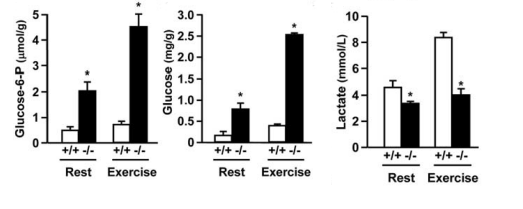Glycogen storage disease type VII or Tarui disease is a rare, autosomal recessive muscular glycogenosis characterized by exercise intolerance, rhabdomyolysis episodes, i.e., disintegration of muscle associated with excretion of myoglobin in the urine, and hemolytic anemia, i.e., breakdown of circulating erythrocytes with release of hemoglobin into plasma, generally revealed by laboratory tests. The molecular origin of this disease is a deficiency of muscle PFK-1 with a partial deficiency of the enzyme in erythrocytes. Important characterization of the metabolic imbalances associated with this disease has been obtained by genetically generating mice with muscle PFK-1deficiency. The histogram diagrams below contrast levels of three glycolytic intermediates in skeletal muscle tissue of wild type (+/+) normal mice with that in PFK-1 deficient (-/-) mice during rest and exercise. Using the material discussed in the previous parts of this question, discuss why lactate concentrations in the PFK-1 deficient mice do not change significantly during exercise in comparison to wild type mice
Glycogen storage disease type VII or Tarui disease is a rare, autosomal recessive muscular
glycogenosis characterized by exercise intolerance, rhabdomyolysis episodes, i.e., disintegration of
muscle associated with excretion of myoglobin in the urine, and hemolytic anemia, i.e., breakdown of
circulating erythrocytes with release of hemoglobin into plasma, generally revealed by laboratory tests.
The molecular origin of this disease is a deficiency of muscle PFK-1 with a partial deficiency of the
enzyme in erythrocytes. Important characterization of the
disease has been obtained by genetically generating mice with muscle PFK-1deficiency. The histogram diagrams below contrast levels of three glycolytic intermediates in skeletal muscle tissue of wild
type (+/+) normal mice with that in PFK-1 deficient (-/-) mice during rest and exercise. Using the
material discussed in the previous parts of this question, discuss why lactate concentrations in the
PFK-1 deficient mice do not change significantly during exercise in comparison to wild type mice.

Trending now
This is a popular solution!
Step by step
Solved in 3 steps






